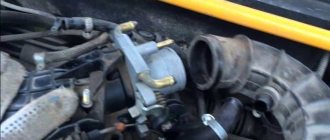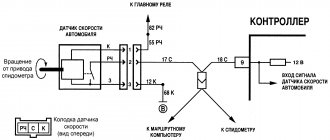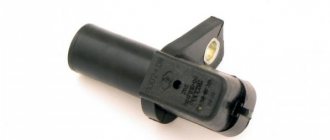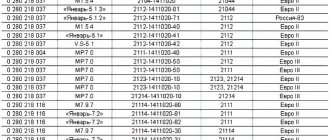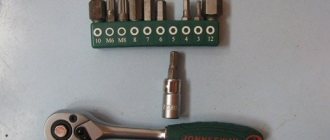A speed sensor (DS) is structurally provided on every car. It is designed to determine the speed of movement of the car and transmit the received data to the dashboard, or rather to the speedometer.
It is prohibited to operate a vehicle with a faulty speedometer, as this can lead to an accident or fines from the traffic police.
If the product breaks down, checking it does not take much time, and to complete the work you only need a multimeter or test lamp.
What is the device? What does it look like and where is it located? What are the signs of malfunctions, and how to check the speed sensor? These and other questions will be addressed in this article.
First, we will look at the main testing methods, and then we will touch on individual models: Lada Kalina, Priore, Granta, Gazelle, Nissan, Niva, VAZ 2110, VAZ 21093 injector.
Purpose and location
As we noted above, the sensor determines the speed of the vehicle and transmits the received data to the speedometer, where they are reflected. Speedometers are either pointer or liquid crystal.
The shaft is the main element of the product. It rotates and passes near a special mark once per circle. At this moment, a pulse is sent to determine the number of revolutions per minute.
The number of signals depends on the rotation speed of the shaft, the value of which is coordinated with the transmission shafts and wheel diameter. Thanks to this, information from the speed sensor is converted and sent to the speedometer.
The DS consists of three elements - the speedometer drive, the casing and the controller, through which the product is connected to the vehicle's electrical network. Depending on the make and model of the car, the appearance and design may vary.
The location of the speed sensor is also different. Before checking it, you need to find the device.
Common mounting locations are the transmission output shaft or transfer case (for all-wheel drive vehicles).
Older models used a cable that was screwed onto the speedometer drive. Today its place is taken by a speed sensor, connected using ordinary wires.
Dismantling
To check the integrity of the rod, you will have to remove the part from its seat. Next, the rod itself is checked. There should be no free play, distortions, or “eaten” edges of the rod.
Replacement
If the cause of poor pulse transmission is not dirty contacts, the speed sensor will have to be replaced. For this you will need:
- Loosen the air filter bellows clamp.
- Remove the corrugation.
- Disconnect the electrical connector from the sensor.
- Using a size 22 wrench, unscrew the sensor. This is done extremely carefully so as not to tear off the plastic edges of the part.
- Remove the part from the mounting location.
- Clean the EMF installation site from dirt.
- Secure the new unit and assemble the remaining components in exactly the reverse order.
Attention! Lada Kalina cars were equipped with various modifications of the EMF. Replacement must be made only with a completely identical option.
When is a check needed?
Checking the DS is necessary for the following symptoms:
- unstable engine operation at idle;
- the speed of the machine is shown incorrectly;
- in normal operation, the car consumes more fuel;
- the speedometer does not show information (in case of complete failure);
- deterioration in acceleration dynamics;
- error information appears on the central display.
These signs may indicate other failures, for example, those related to the fuel or air systems.
Therefore, before making a final “verdict”, the speed sensor must be checked, and if the malfunction is confirmed, it must be replaced.
Symptoms of a malfunctioning throttle position sensor.
Next, I will list possible problems in the operation of the car and how to detect that your TPS is not working.
- Perhaps the most obvious and striking example of detecting a malfunction is the appearance of the Check Engine signal (in Russian, simply “check”).
- The on-board computer will also help to diagnose a breakdown; for this you need to analyze the fuel consumption. If it has increased, then the problem may also be with the TPS sensor.
- The following types of breakdowns can be diagnosed visually or auditorily.
For example, when starting the engine, the speed immediately jumps as if the gas pedal is pressed, or, on the contrary, the engine starts hard and stalls. - Engine speed fluctuates at idle. The engine spontaneously begins to increase speed and then reduce it.
- During the trip, the car does not respond or reacts poorly to pressing the gas pedal, or vice versa, when pressed slightly, the car accelerates significantly.
Operating principle of the speed sensor
The operation of the speed sensor is based on the Hall effect. Pulses from the device are sent to the car's ECU, where they are converted into the necessary readings. It is known that 6000 pulses are transmitted per kilometer. The faster the signals arrive at the ECU, the higher the movement speed.
The electronic control unit receives impulses, processes them and provides information to the speedometer in a form understandable to humans. To determine the speed, a special algorithm is installed in the ECU.
As noted, the operation of the speed sensor is based on the Hall effect - a physical phenomenon that implies the appearance of voltage when a conductor is placed in a magnetic field.
While driving, rectangular or wave-shaped signals with a voltage of 1 to 5 Volts appear at the output of the product.
The use of a special scheme and program allows you to calculate the current speed of the car and other important parameters - average daily mileage, total distance traveled and other data.
For the advanced, below is a schematic diagram of how a car speed sensor works.
Signs and causes of malfunction
Symptoms indicating the need to check the speed sensor have already been indicated above. The main signs of a malfunction are the absence of readings on the speedometer, increased “gluttony” of the engine, malfunction of the engine at idle, deterioration in dynamics, etc.
A breakdown of the sensor may be indicated by engine stopping while driving, failure of the electric power steering wheel, or increased sensitivity of the FLS (for example, for Lada Kalina).
Common causes of sensor failure:
- violation of the integrity of contacts;
- oxidation at joints;
- open circuit;
- insulation melting;
- wear of the speedometer cable, etc.;
- strong vibration of the device;
- dirt ingress;
- temperature changes;
- Other reasons.
If you ignore problems, engine malfunctions occur and wear on its elements increases.
As a rule, the cause of problems is dirty contacts, which should be cleaned and treated with Lithol.
If there is a break in the electrical circuit, the damage should be looked for near the connection connector. This is where the wires are most susceptible to bending and breaking. Sometimes the insulation becomes damaged where the exhaust manifold is mounted.
When exposed to high temperatures, the insulation can be damaged, which leads to short-circuiting of the wires.
With prolonged use, the speedometer cable wears out, which eventually develops cracks and breaks, which leads to failure of the controller.
An equally common cause of speed sensor failure is a broken circuit, so before replacing the device you need to make sure it is working properly.
To begin with, you should discard the power supply and examine the contacts from the point of view of contamination. After cleaning, the surface is treated with Litol lubricant.
During the test, measure the resistance in the grounding circuit; it should be equal to one Ohm.
When analyzing a fault, consider the following:
- If the controller is working properly and the gear is intact, it is possible that the device is not receiving power or there is a short circuit in the network.
- The readings on the dashboard involve the ECU and ABS, so you need to check the integrity of the wire running from the speedometer to the unit. It happens that the dashboard itself fails.
- On cable-driven machines, the cause of the malfunction is often hidden in old oil on the gear or a worn square at the end of the cable.
Before replacing the sensor, make sure what is causing the problem. The algorithm of actions is as follows:
- take the cable out of the box, twist it and look at the speedometer’s reaction;
- check the electrical part of the speed indicator;
- if there is no voltage, you need to make sure the fuses are intact;
- remove the speed sensor, install the cable in the KPI and drive a short distance (if there is no data on the speedometer, we can talk about a breakdown of the DS).
Finding out the cause of the malfunction requires an integrated approach, as does checking the sensor (discussed below).
Also read about signs of a malfunctioning mass air flow sensor.
Examination
VAZ cars and a number of other cars have a speed sensor that operates on the Hall effect. It produces six pulses per revolution. But there are other devices - inductive or reed type.
The standard version of the controller operating on the Hall effect deserves the most attention.
The device has three contacts - pulse, ground and voltage. At the same time, car owners have three verification methods at their disposal.
First option:
- Removing the speed sensor from the car.
- Move the multimeter to the voltage change position (Volts).
- Determining the purpose of the contacts (pinout).
- Search for the pin that receives the pulse signal.
- Connect the “plus” of the multimeter to this terminal. “Minus” is connected to the ground terminal (you can use the car body).
- Rotate the shaft and monitor the voltmeter readings. The higher the cranking speed, the higher the voltage level.
To simplify the rotation process, a small piece of tube (for example, vinyl insulation) is put on the speed sensor axis.
The second method (suitable for Hall effect sensors) without removal:
- Check that the controller is connected.
- Lifting one wheel of the car. The goal is to lift it off the surface for easy rotation.
- Preparing the multimeter - switching the scale to measure voltage.
- Connecting the probes to the contacts in the same way as described above.
- Rotation of a wheel disconnected from the surface and evaluation of the results obtained.
The voltage level and frequency must change. This indicates that the speed sensor is working properly. If the readings remain unchanged, the device has failed.
The third method is with a control lamp:
- Preparing the warning lamp and turning on the ignition.
- Raising the car wheel for further rotation.
- Connecting one wire to the battery positive, and the second to the signal contact of the DC;
- Spin the wheel and watch the light bulb.
If the lamp blinks noticeably when the wheel rotates, this indicates that the speed sensor is working properly.
The fourth method is with a warning lamp and removing the speed sensor:
- Remove the controller from its original location.
- Build the circuit shown below.
- Connect the wires to the pins according to the pinout below.
- We connect one terminal to ground, the second to the battery positive. The latter can be not only for a car - you can use any 12 V power source.
- Take a piece of brake pipe and place it on the sensor rod. To make it easier to control the number of revolutions, screw electrical tape onto the tube, as shown below.
- Start rotating the rod using the tube. As a rule, the light should blink 6 times in one revolution, but it all depends on the make of the car.
Automatic transmission check
In cars with automatic transmission, it is better to trust the professionals. The reason is that such cars have many electronic components that are closely interconnected with each other (directly or through the ECU).
An attempt to independently check the speed sensor can lead to even greater damage and breakdown of the automatic transmission system.
There are many cases where attempts at self-checking ended in expensive repairs or the need to sell the car.
Oil
With the introduction of the new box, the amount of oil also changed. Thus, for the VAZ-2181 gearbox, the oil volume decreased by 30%. The requirements for oil have also changed - AvtoVAZ switched from mineral to synthetic gear oils. This applies to both old gearbox models and new ones. The manufacturer pours oil into the gearbox and writes in the instructions that it will last for 5 years or for the entire life of the gearbox. But in reality it needs to be changed.
The oil life of the Kalina gearbox is approximately 30 thousand km. You can choose any of the domestic transmission products as gearbox oil. Thus, domestic car enthusiasts speak well of the products of Lukoil and Rosneft. You can also purchase imported oils - for example from Zic. The box will say “thank you” for this.
Checking the drive
Sometimes you only need to check the DC drive. Algorithm of actions:
- Raising one wheel using a jack.
- Search for the speed sensor drive (it is easy to find, thanks to its “sticking out” from the gearbox).
- Rotate the wheel with your free foot.
It is easy to determine by tactile sensations whether the drive is working or not. If the device does not function, it is worth disassembling it and assessing the condition of the teeth on the gears. If you lack experience, it is better to entrust the work to a specialist.
Features of the switching mechanism
If we recall the design and principle of operation of VAZ gearboxes for the Samara series, then the shift mechanism in them was from below and immersed in an oil bath. After parking in the cold, the oil in the gearbox thickened and the gears shifted very, very slowly until the engine and gearbox warmed up. At the bottom of the gearbox, clamps for the fork and reverse gear rod, a reverse sensor, and a gear selection seal were installed - each element was a potential source of oil leakage. Sealants helped with this, but they did not radically solve the problem. And at AvtoVAZ they decided to move the mechanism up.
The new switching mechanism in the VAZ-1119 (“Kalina”) is a special separate unit. It can be installed and removed without the need to disassemble the gearbox. This is an excellent solution and is useful not only for fast and cheap production, which is also appreciated by repairmen. Now repairing the switching mechanism has become much easier. Thanks to the use of a selector grid, all gears are switched on much more accurately. The mechanism also has a lock against engaging reverse gear - reverse gear is only available from neutral.
The icing on the cake, or rather in the box, is the special selector plate. It was she who influenced the accuracy of gear shifting. The plate replaced the previously standard locking and return springs. To develop the plate, it took a long time to analyze the work of a person with a gearbox selector. The force on the lever was calculated using a special software package.
Checking induction DC and with reed switch
Note that speed controllers differ in the signal coming from the wheels. Taking this fact into account, the DS check is also built:
- WITH REED SWITCH. The signals are rectangular in shape. The cycle is from 40 to 60 percent. Switching occurs at a voltage from 0 to 5 Volts or when the battery voltage is reached.
- INDUCTION. With these speed sensors, the signal is in the form of waves, so the voltage changes based on the speed at which the wheel spins. This can be seen on the oscilloscope. Otherwise the principle is identical to what happens on the crankshaft angle controller.
Replacement instructions
If the malfunction is confirmed and the sensor needs to be replaced, the work is done according to the following algorithm:
- Turn off the ignition, open the hood and remove the terminal from the battery.
- Search for speed sensor. It can be located in different places, it all depends on the car model. This information can be found in the service book.
- Cleaning from contaminants. This is necessary to avoid foreign elements getting into the transmission.
- Removing the power connector and unscrewing the device. If you cannot disconnect the controller, you should treat the connection location with WD-40. It is not recommended to apply excessive force, as this may lead to damage to the integrity of the case. After applying the specified liquid, you need to wait some time.
- Removing the old and installing a new sensor, connecting wires.
- Resetting errors on the ECU (for models that have an electronic unit). If this work is not done, the light on the dashboard will light up, and the ECU will send signals about a breakdown.
Subtleties of checking for different car models
Depending on the vehicle, the location, malfunctions and details of the check may vary.
VAZ-2110
A common malfunction on the “ten” is incorrect operation of the odometer, expressed in incorrect speed data. The cause may be a broken speed sensor or drive.
Sometimes the malfunction is due to oxidation of the connectors or damage to the wiring.
The sensor is located near the collector, so the cause of the breakdown may be damage to the wiring due to high temperature.
To check the performance of the product, you can use one of the three methods discussed above.
If the device is faulty, replacement will require a 21 or 22 key. When purchasing a new speed sensor, it is recommended to choose a product with a metal rod. It lasts longer and is more reliable.
Kalina
As with other models, a popular reason for DC failure is damage to the wiring (oxidation, rust, poor contact, melting wires, etc.). A multimeter is used for control.
The probes are connected to the central contact (“plus”) and to the body (“minus”). When vibrations occur, the voltage should vary from 0.5 to 10 V.
You can check the operation in other ways - by hanging the wheel or using a test lamp.
The location of the Lada Kalina DS is shown below.
Priora
There are a number of features in checking the Lada Priora speed sensor. Often a problem with it is indicated by error P0501.
Algorithm of actions:
- Inspection of the controller.
- Checking the quality of grounding at the contact connection.
- Reference voltage measurement. The Priora speed sensor has wires of different colors. It is located behind the collector.
Brown has a minus sign and pink has a plus sign. The signal wire is made in gray color. Using a multimeter set to voltage measurement mode, you need to check the reference U. The optimal value is from 12 V. If there is no voltage or it is less than the set parameter, you need to charge the battery and look for a breakdown elsewhere (ECU or power supply circuit). - Checking the quality of connector connections using a thin needle or plate. It is important that the contact groups do not fall out of the connector.
- Checking the speed sensor using an oscilloscope (the wheel must rotate at a speed of more than 5 km/h).
Before checking the DC, it must be removed from the vehicle, but the wires must not be disconnected.
Next, turn on the ignition and check the output voltage. To do this, you need to slowly change the rotation speed of the axis. The curve should have a voltage of five to one volt in the reverse direction.
If the voltage remains unchanged, this indicates a breakdown. An additional sign of failure is the engine stopping when changing gears, failure of the electric power steering.
To check the speed sensor, you can use a simulator - a device that changes the pulse frequency by pressing plus or minus. Using the product you can also check the machine's ECU.
Gazelle
To check the Gazelle speed sensor, you need to take the following steps:
- Unscrew the screws that secure the hatch near the gearshift knob.
- Remove and unscrew the DS chip.
- Check the operation of the device, starting with checking the grounding on the third contact. The first contact should have a voltage of +12 V. The black wire is “negative”, the yellow wire is “positive”. Green goes to the DS and instrument panel.
It is worth considering that the “positive” signal is sent to the DS and the reverse signal. If the reversing lights turn on after moving the gearshift knob to the appropriate position, there is no need to check the fuses.
Nissan
Nissan uses two input signals from the automatic transmission control unit - from the speed sensor and the vehicle speed sensor.
The first determines the rotation speed of the secondary shaft and sends information to the unit, and the second is used as an additional controller. It sends data when the master node is faulty.
The Nissan speed sensor is built into the speedometer assembly and plays the role of an additional device. Symptoms of a malfunction are dropping into neutral or illogical gear shifting.
The sensor itself is located behind the left fender liner, and to replace it you need to remove the left plastic protection (using the example of a Nissan Liberty).
If error “2” appears, you need to check the DC chain, the integrity of the wires and connectors. Studying the operation of the controller itself is carried out according to the standard scheme:
- removing the speed sensor (VSS) from the transmission housing;
- connecting a voltmeter to the terminals and switching the multimeter to AC mode;
- rotation of the drive gear (there should be a voltage with an amplitude of about 0.5 V);
- If there is no U, the sensor needs to be changed.
If tension is present, you need to look for another reason.
To replace the DS you need:
- put the car on a jack;
- discard the wiring from the sensor;
- unscrew the coupling bolt, loosen the clamp and remove the device from the transmission;
- check the condition of the o-ring (if necessary, replace it);
- Put the product in the reverse order.
Niva
The Niva's speed sensor is located on the transfer case. It is made in a plastic case, and inside there is an electronic part.
The device is highly fragile, so you need to be careful.
Check procedure:
- disconnecting the sensor;
- connecting the red (“positive”) probe to the product contact;
- connecting the minus to ground;
- fixing the tube on the shaft for rotation;
- switching the device to voltage measurement mode;
- shaft rotation and U control (this parameter must be changed).
To replace, you need to disconnect the terminals from the battery, press the plastic lock and use a wrench to unscrew the sensor (to simplify the work, you can use WD-40.
VAZ 21093 injector
The VAZ 21093 injector speed sensor is located on the speedometer drive mechanism (at the gearbox). To find it, just open the hood and remove the adsorber.
Performing the last step is not necessary, but it is easier to get to the desired point in another way. On the right CV joint side there is a wire that goes to the gearbox. It connects to the connector of the desired sensor.
In the case of injection VAZ-2109, the main sign of a speed sensor failure is the engine stopping at idle or when the clutch is pressed.
Also, a light on the dashboard lights up asking you to check the engine (code 24). For control, one of the three methods discussed earlier is used.
How to check the throttle position sensor on a VAZ with a multimeter?
As I said above, we will carry out all the work on a VAZ car, if you have a different car, then the situation will not be much different. First, you need to find the throttle position sensor itself in the engine compartment. On a VAZ 2110 car it is located after the air intake on the side of the car interior.
Pay attention to the area outlined in a red rectangle.
First TPS test
The first step is to check with a multimeter whether there is current at these two terminals. Since perhaps the wire was simply broken due to this and the sensor itself does not work. When the ignition is turned on, the multimeter should show a voltage of about 5V, a spread in the range of 0.5V is allowed.
The sensor can be diagnosed without removing it, but if you do not have the appropriate connector, it will be extremely difficult to find it using the probes of a multimeter. However, we can carry out the first test without removing the sensor. To do this, remove the terminal from the battery, disconnect the chip with wires from the sensor and plug a small wire into the pin of the wire responsible for transmitting the signal to the on-board computer, after which we put the chip back on the sensor. For the VAZ family of cars it looks like this.
We connect one multimeter probe to the free end of the additional wire, and the second probe to the battery negative. We put the terminals on the battery and turn on the ignition. No need to start the car!
Switch the multimeter to DC measurement mode. Next, with the help of a second person, you need to smoothly press the gas pedal all the way or pull the throttle cable yourself and monitor the multimeter readings.
The voltage with the throttle valve fully closed should be about 0 - 0.5V, with the throttle fully open - about 5V. During the process of opening and closing the throttle valve, the multimeter readings should not jump or skip. When the damper is smoothly opened and closed, the readings should also change smoothly.
Second TPS test
The throttle position sensor can also be checked with a multimeter by measuring its resistance. The multimeter must be switched to resistance measurement mode. Since there is no way to connect to it, the sensor must be removed.
We unscrew the two bolts with a Phillips screwdriver, disconnect the wire and remove the sensor. Using additional wires, you need to connect to the negative terminal of the sensor with one multimeter probe and connect the second probe to the signal wire terminal. Then begin to smoothly turn the sensor mount on the throttle valve, thereby simulating the opening and closing of the valve.
For a VAZ car in a fully closed position, the resistance is 1.5 kilo-ohms, in a fully open position it is 7.5 kilo-ohms. For other cars the parameters are similar. The most important thing is that there are no jumps during the testing process. Resistance indicators should also change smoothly.



